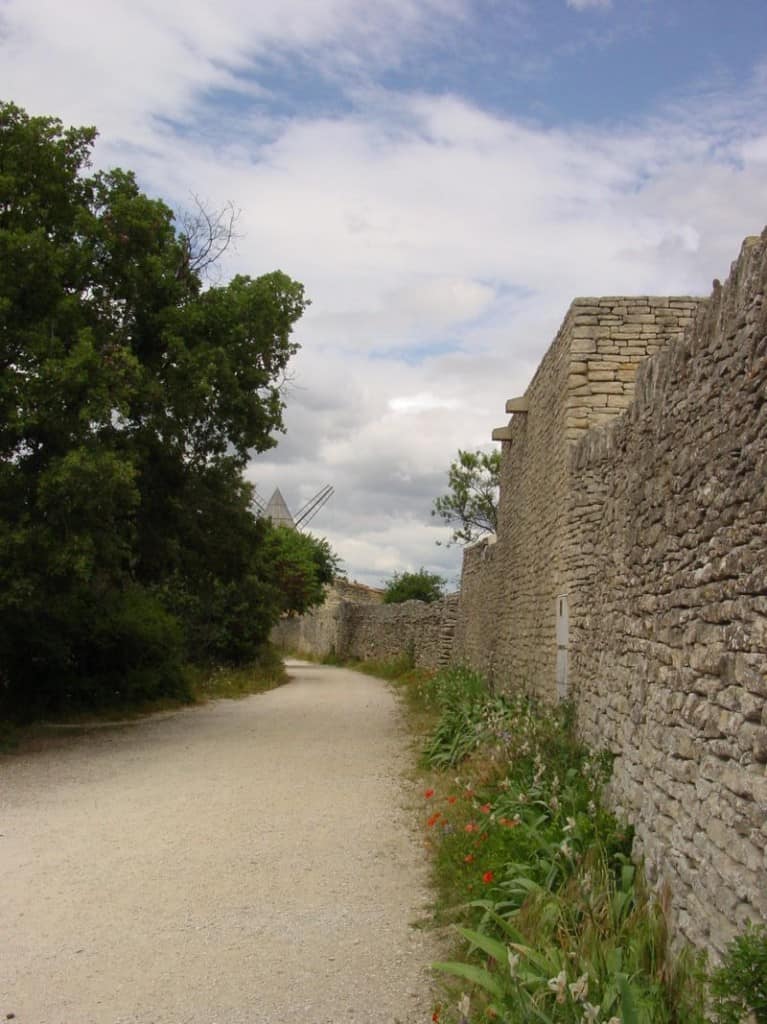
When I think of the mountain villages of Provence the first thing that comes to mind is the dry stack stone walls.
They are everywhere and have been standing for hundreds of years. The craftsmanship to build such tall walls is outstanding. While it is usually cost prohibitive to build dry stack stone walls in the garden, when suitable rock is readily available on site we have used it with great success.
The stone walls on the left have recently been reworked, the walls on the right have slumped a little but are still doing the job. The vertically laid sharp stones capping the wall are there to keep unwanted guests out of the property. I have seen broken glass or even broken bottles set in the top of walls for the same purpose in other countries.
A great deal of work went into this corner and it has held up to the wear and tear it obviously has taken. This is typically recreated by the manufactured corners used for veneered concrete masonry. More expensive projects will use real ledger stone veneered over concrete block, a great substitute, but there is nothing like the character of a real stone wall.
Either way it’s a great look and we have incorporated plants into walls. Sedums, Sempervivens, Alyssum, Thyme and Germander all work well. The trick is either to set up a drip system within the wall or start the plants in the rainy season and remember to water occasionally in the summer.
This is the back of the Gite I stayed in early spring. This gravel walk is actually 6 ft. wide but as the lavender grows it spills into the walkway. When it blooms it brushes against you, which is wonderful if you like the smell of lavender. We created a Lavender walk in one of our gardens, it has a magical quality to it.
There are a surprising number of Olive orchards and Olive trees in the Gardens throughout Provence. They are a smaller more cold hardy Olive tree than you find in Spain. Portugal, Greece or Italy. Picholine olives come from from these trees which were planted during medieval times and are being rejuvenated. Olive trees are remarkably well adapted to Northern California. In the right place in a garden their silvery foliage and magnificent trunks add a wonderful ambience. Their fruit can be a real nuisance when planted in the wrong place, like turf areas or over patios. large specimen trees readily transplant and create an instant Mediterranean feel. There are many more varieties beside the Mission Olive to choose from and I especially like the mature Sevillano Olive trees we installed on our projects. Mature is a relative term as Olives can live for over 1000 years.
Unlike Italy however, they aren’t used just in the cemeteries. So often in our gardens in California they are planted in very narrow areas as a screen. Most of the time they become much to large for the space and either get removed or a hack prune job. I like to use them either singly to emphasis the verticality of a structure or in groupings, especially at an entrance.
Vineyards range from large operations to someone planting their private yard for their own wine production. If you have the space and the interest this is a fantastic way to landscape a property. We have incorporated a few small vineyards into our designs. This area reminds me of the upper ridges on the east side of the Napa Valley. In fact Provence has many similarities in feel to both Napa and Sonoma Valleys, excluding the incredible Roman, Medieval, Renaissance and Belle Epoch history and Architecture…lol. That is Mont Ventoux of Tour de France fame in the background.
This wall was recently added to create additional parking near the entrance to a small mountain town. The poppies were probably part of a hydro-seed mix to cover the soil and prevent erosion. I have seen them used just a few times in the Napa Valley. I would love to see them used more.
I clearly remember the tall Hollyhocks my aunt planted in her Bay Area garden. As a kid, it was fun to wait for them to go to seed and pick the seeds for use the next year. They are rather dramatic against this ruin of a stone monument.
This defies common sense but with the right plant material it can really soften up too much hardscape. I have incorporated tiny planting pockets into walkways and patios and have planted small vines and espaliers in them. This works especially well in paver patios, just pop out a few of the pavers and plant directly into the mix below. It requires very tough plant material, a drip system or occasional hand watering. I have had great success with espaliering Fig trees, just don’t let them get too large.

Stone Pines are found in the gardens and surrounding landscape of Southern France, Italy, Spain, Portugal and many other Mediterranean countries.
In Portugal they are planted in large plantations and used in the pulp industry. They are great landscape specimen trees only for a large garden. Some of the specimens planted in Capitol Park in Sacramento in the 19th century are gigantic and require special support. These pines trees have a rounded shape and blend wonderfully with Oaks, Bay trees, Madrones, etc.
It is so simple yet it has a very dynamic feel to it. Note the short, sharp spikes between the uprights. I wouldn’t want to put my foot on those to try and jump the gate, yeeow!
The simplicity of the structure, it’s slight arch, diminished scale and color are very attractive. I’m not sure it can support a Virginia Creeper vine, but it felt incredibly sturdy to the touch. I’m also not sure of the window covering, how do you escape in an emergency? Obviously different building codes.
The design motif was very different, more similar to architectural patterns you see in Southern Spain or Portugal. Maybe there is a Moroccan iron worker in town?















Follow Us!